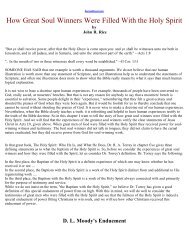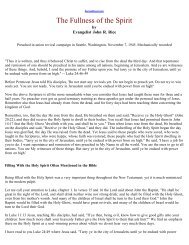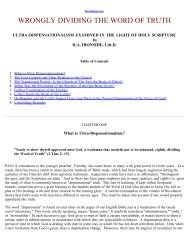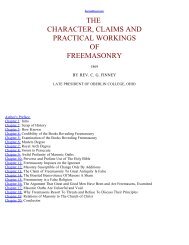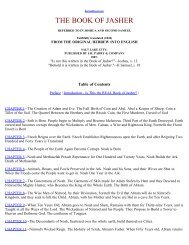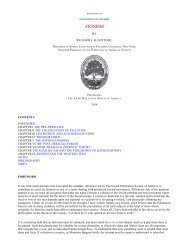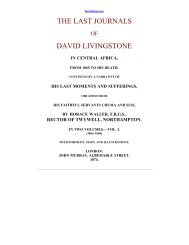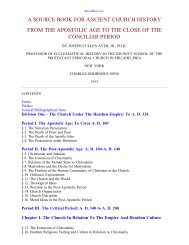Legends of Babylon and Egypt in Relation to Hebrew Tradition.pdf
Legends of Babylon and Egypt in Relation to Hebrew Tradition.pdf
Legends of Babylon and Egypt in Relation to Hebrew Tradition.pdf
Create successful ePaper yourself
Turn your PDF publications into a flip-book with our unique Google optimized e-Paper software.
<strong>in</strong> the first lecture we noted some newly recovered evidence upon this po<strong>in</strong>t. Moreover, the dynasty <strong>to</strong> which<br />
Hammurabi belonged came orig<strong>in</strong>ally from the north-eastern border <strong>of</strong> Canaan <strong>and</strong> Hammurabi himself exercised<br />
authority <strong>in</strong> the west. Thus a plausible case could be made out by exponents <strong>of</strong> this theory, especially as many parallels<br />
were noted between the Mosaic legislation <strong>and</strong> that conta<strong>in</strong>ed <strong>in</strong> Hammurabi's Code. But it is now generally<br />
recognized that the features common <strong>to</strong> both the <strong>Hebrew</strong> <strong>and</strong> the <strong>Babylon</strong>ian legal systems may be paralleled <strong>to</strong>-day <strong>in</strong><br />
the Semitic East <strong>and</strong> elsewhere,[1] <strong>and</strong> cannot therefore be cited as evidence <strong>of</strong> cultural contact. Thus the hypothesis<br />
that the <strong>Hebrew</strong> patriarchs were subjects <strong>of</strong> <strong>Babylon</strong> <strong>in</strong> Palest<strong>in</strong>e is not required as an explanation <strong>of</strong> the facts; <strong>and</strong> our<br />
first period still st<strong>and</strong>s or falls by the question <strong>of</strong> the Mosaic authorship <strong>of</strong> the Pentateuch, which must be decided on<br />
quite other grounds. Those who do not accept the traditional view will probably be content <strong>to</strong> rule this first period out.<br />
[1] See Cook, /The Laws <strong>of</strong> Moses <strong>and</strong> the Code <strong>of</strong> Hammurabi/, p. 281 f.; Driver, /Genesis/, p. xxxvi f.; <strong>and</strong> cf. Johns,<br />
"The Laws <strong>of</strong> <strong>Babylon</strong>ia <strong>and</strong> the Laws <strong>of</strong> the <strong>Hebrew</strong> Peoples/ (Schweich Lectures, 1912), pp. 50 ff.<br />
Dur<strong>in</strong>g the second period, that <strong>of</strong> the settlement <strong>in</strong> Canaan, the <strong>Hebrew</strong>s came <strong>in</strong><strong>to</strong> contact with a people who had used<br />
the <strong>Babylon</strong>ian language as the common medium <strong>of</strong> communication throughout the Near East. It is an <strong>in</strong>terest<strong>in</strong>g fact<br />
that among the numerous letters found at Tell el-Amarna were two texts <strong>of</strong> quite a different character. These were<br />
legends, both <strong>in</strong> the form <strong>of</strong> school exercises, which had been written out for practice <strong>in</strong> the <strong>Babylon</strong>ian <strong>to</strong>ngue. One<br />
<strong>of</strong> them was the legend <strong>of</strong> Adapa, <strong>in</strong> which we noted just now a distant resemblance <strong>to</strong> the <strong>Hebrew</strong> s<strong>to</strong>ry <strong>of</strong> Paradise. It<br />
seems <strong>to</strong> me we are here st<strong>and</strong><strong>in</strong>g on rather firmer ground; <strong>and</strong> provisionally we might place the beg<strong>in</strong>n<strong>in</strong>g <strong>of</strong> our<br />
process after the time <strong>of</strong> <strong>Hebrew</strong> contact with the Canaanites.<br />
Under the earlier <strong>Hebrew</strong> monarchy there was no fresh <strong>in</strong>flux <strong>of</strong> <strong>Babylon</strong>ian culture <strong>in</strong><strong>to</strong> Palest<strong>in</strong>e. That does not occur<br />
till our last ma<strong>in</strong> period, the later Judaean monarchy, when, <strong>in</strong> consequence <strong>of</strong> the westward advance <strong>of</strong> Assyria, the<br />
civilization <strong>of</strong> <strong>Babylon</strong> was once more carried among the petty Syrian states. Israel was first drawn <strong>in</strong><strong>to</strong> the circle <strong>of</strong><br />
Assyrian <strong>in</strong>fluence, when Arab fought as the ally <strong>of</strong> Benhadad <strong>of</strong> Damascus at the battle <strong>of</strong> Karkar <strong>in</strong> 854 B.C.; <strong>and</strong><br />
from that date onward the nation was menaced by the <strong>in</strong>vad<strong>in</strong>g power. In 734 B.C., at the <strong>in</strong>vitation <strong>of</strong> Ahaz <strong>of</strong> Judah,<br />
Tiglath-Pileser IV def<strong>in</strong>itely <strong>in</strong>tervened <strong>in</strong> the affairs <strong>of</strong> Israel. For Ahaz purchased his help aga<strong>in</strong>st the allied armies <strong>of</strong><br />
Israel <strong>and</strong> Syria <strong>in</strong> the Syro-Ephraimitish war. Tiglath-pileser threw his forces aga<strong>in</strong>st Damascus <strong>and</strong> Israel, <strong>and</strong> Ahaz<br />
became his vassal.[1] To this period, when Ahaz, like Panammu II, "ran at the wheel <strong>of</strong> his lord, the k<strong>in</strong>g <strong>of</strong> Assyria",<br />
we may ascribe the first marked <strong>in</strong>vasion <strong>of</strong> Assyrian <strong>in</strong>fluence over Judah. Traces <strong>of</strong> it may be seen <strong>in</strong> the altar which<br />
Ahaz caused <strong>to</strong> be erected <strong>in</strong> Jerusalem after the pattern <strong>of</strong> the Assyrian altar at Damascus.[2] We saw <strong>in</strong> the first<br />
lecture, <strong>in</strong> the monuments we have recovered <strong>of</strong> Panammu I <strong>and</strong> <strong>of</strong> Bar-rekub, how the life <strong>of</strong> another small Syrian<br />
state was <strong>in</strong>evitably changed <strong>and</strong> thrown <strong>in</strong><strong>to</strong> new channels by the presence <strong>of</strong> Tiglath-pileser <strong>and</strong> his armies <strong>in</strong> the<br />
West.<br />
[1] 2 K<strong>in</strong>gs xvi. 7 ff.<br />
[2] 2 K<strong>in</strong>gs xvi. 10 ff.<br />
Hezekiah's resistance checked the action <strong>of</strong> Assyrian <strong>in</strong>fluence on Judah for a time. But it was <strong>in</strong>tensified under his son<br />
Manasseh, when Judah aga<strong>in</strong> became tributary <strong>to</strong> Assyria, <strong>and</strong> <strong>in</strong> the house <strong>of</strong> the Lord altars were built <strong>to</strong> all the host<br />
<strong>of</strong> heaven.[1] Towards the close <strong>of</strong> his long reign Manasseh himself was summoned by Ashur-bani-pal <strong>to</strong> <strong>Babylon</strong>.[2]<br />
So when <strong>in</strong> the year 586 B.C. the Jewish exiles came <strong>to</strong> <strong>Babylon</strong> they could not have found <strong>in</strong> its mythology an<br />
entirely new <strong>and</strong> unfamiliar subject. They must have recognized several <strong>of</strong> its s<strong>to</strong>ries as ak<strong>in</strong> <strong>to</strong> those they had<br />
assimilated <strong>and</strong> now regarded as their own. And this would naturally have <strong>in</strong>cl<strong>in</strong>ed them <strong>to</strong> further study <strong>and</strong><br />
comparison.<br />
[1] 2 K<strong>in</strong>gs xxi. 5.<br />
[2] Cf. 2 Chron. xxxiii. 11 ff.<br />
The answer I have outl<strong>in</strong>ed <strong>to</strong> this problem is the one that appears <strong>to</strong> me most probable, but I do not suggest that it is<br />
the only possible one that can be given. What I do suggest is that the <strong>Hebrew</strong>s must have ga<strong>in</strong>ed some acqua<strong>in</strong>tance<br />
with the legends <strong>of</strong> <strong>Babylon</strong> <strong>in</strong> pre-exilic times. And it depends on our read<strong>in</strong>g <strong>of</strong> the evidence <strong>in</strong><strong>to</strong> which <strong>of</strong> the three<br />
ma<strong>in</strong> periods the beg<strong>in</strong>n<strong>in</strong>g <strong>of</strong> the process may be traced.



